This Vegan Chuck Wagon Stew is the best meat-free adaptation of the traditional chuck wagon stew, and features savoury plant-based mince cooked with black-eyed beans [peas], carrots, celery, onions and green peas in a delicious rich home-made gravy.
Nothing beats a good home-cooked, budget-friendly, filling, and satisfying vegetable stew. Although, this chuck wagon stew would also be pretty great cooked over a campfire. Slow cooker and pressure cooker methods also included within the recipe FAQ section.

This meat-free chuck wagon stew is similar to our Vegan Scottish Mince and Tatties recipe which is also a delicious easy meat-free family meal.
Traditional chuck wagon stew
Chuck wagon stew originated from the stews that were prepared on chuck wagons, which were portable kitchens that travelled alongside cowboys during the era of the American wild west [1865-1900]
For more information about chuck wagons see our Camp Fire Stew recipe post and this interesting article about chuck wagons from legendsofamerica.com.
Traditional chuck wagon stew recipes usually included meat, potatoes, vegetables such as carrots and onions, and any spices and herbs that the chuck wagon cook or cookie had available. The spices and herbs were often chilli powder and paprika.
Our vegan chuck wagon stew includes some dried sage as it is possible that sage was added to stews prepared on the trail, as the herb sage grew freely around the United States, with some Native American tribes regarding sage as a sacred plant.
Meat-free chuck wagon stew
This vegan chuck wagon stew is prepared with plant-based mince or crumbles, celery, carrots, onions, garlic, frozen green peas, black-eyed beans [also known as black-eyed peas], chilli powder, dried sage, bay leaf, soy sauce, canned tomatoes, vegetable broth, a little flour to thicken the gravy, and tomato ketchup.
This vegetable stew is so easy to prepare and packed with everyday pantry and fresh ingredients so its a relatively budget-friendly meal that can be tailored to your requirements.
For example, if your out of fresh onion and garlic then simply replace these with the dried varieties, and if your not a fan of dried sage then just add your favourite dried herb or what you do have in your pantry.
Tailoring and adapting your own vegetable stew is easy, and as we all have different needs and tastes, feel free to make your own stew creation.

Vegan chuckwagon stew is so tasty served with creamy mashed potatoes and a few Home-Made Cornbread Muffins to dunk into the delicious rich tomato flavoured gravy. We also have an amazing Slow Cooker Cornbread recipe.
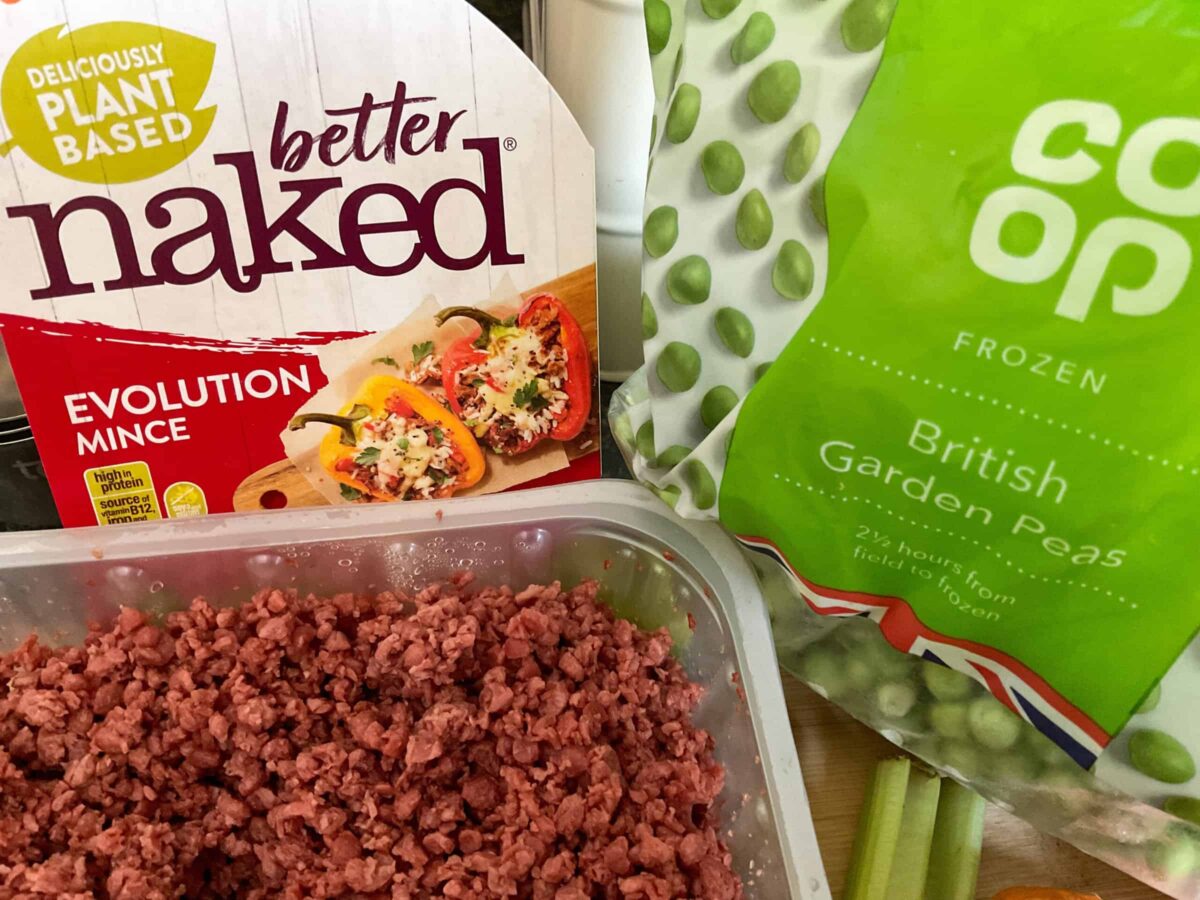
For our vegan chuck wagon stew we used a packet of fresh Better Naked Evolution Mince that we picked up in the reduced section of our local Co-op supermarket, brought home and kept in the freezer for this recipe. This meat-free mince contains beetroot powder which provided a nice red colour to the stew's gravy. Although, any vegan mince or crumbles can be used for this recipe.
How to prepare vegan chuck wagon stew
The carrots and celery chunks are precooked in a little vegetable broth before using for the stew as this extra step reduces the amount of time the stew requires to cook.
Trying to soften up carrots and celery in a tomato based stew can be really difficult as the acidity content of tomato's seems to stop certain vegetables cell walls from softening as quick as they would if they were boiled in a non-tomato based liquid.
Of course, the carrots and celery can simply be cooked in the stew without pre-cooking, but do keep in mind that the stew will need to bubble and cook for longer than the times stated, which may not be an issue especially if your cooking this chuck wagon stew during a camping trip over a camp fire.
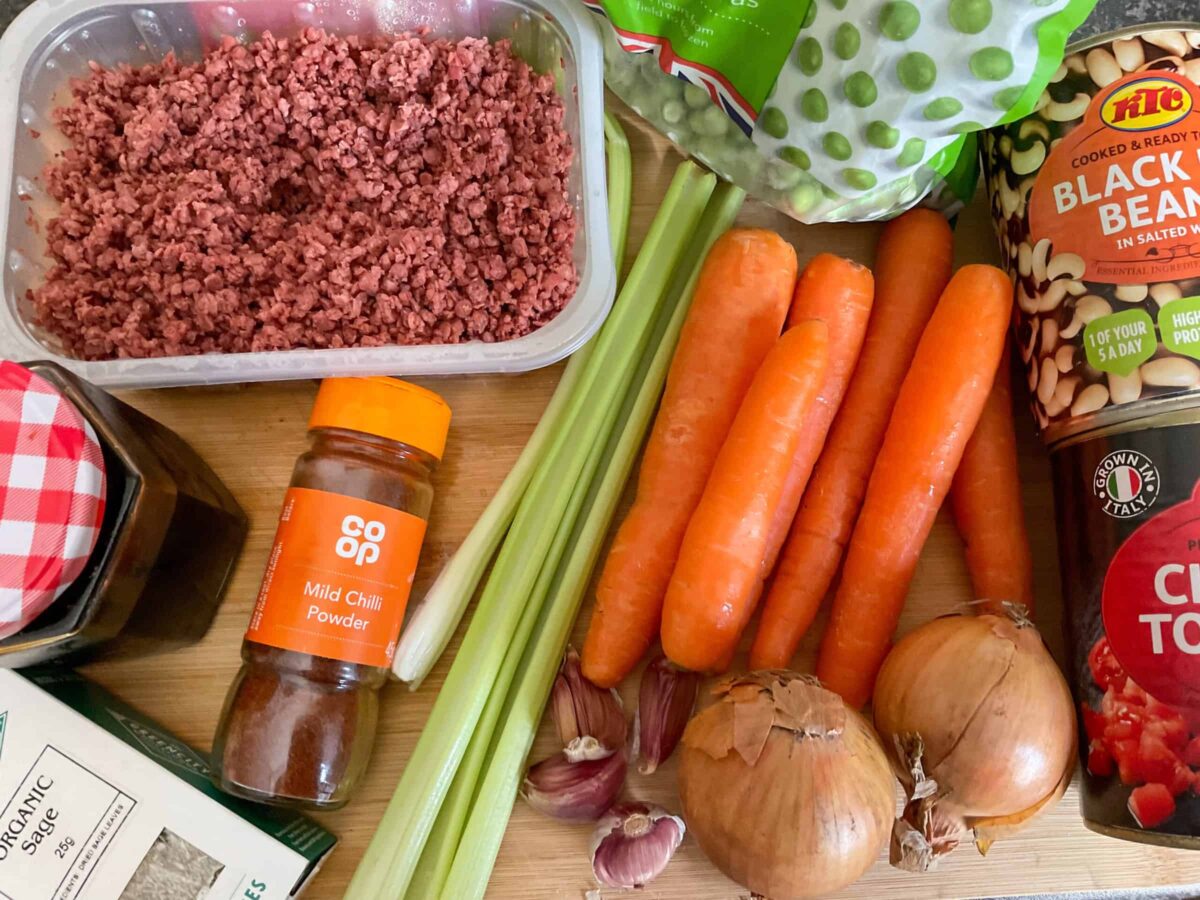
The photo above is the ingredients we used for our vegan chuck wagon stew, although we forgot to add the tomato ketchup to the photo but we did add it to the stew! The ketchup we used was a Polish brand called Pudliszki ketchup, which we sourced on Amazon UK, as the cost of ketchup at our local supermarket was just too expensive even for their own brand! The Polish ketchup has a higher tomato percentage and we think simply tastes much nicer!

Heat the oil and cook the onions for 5 minutes.

Add the garlic and cook for 1-2 minutes.

Next add the pre-cooked carrots and celery, and stir and cook for 1 minute.
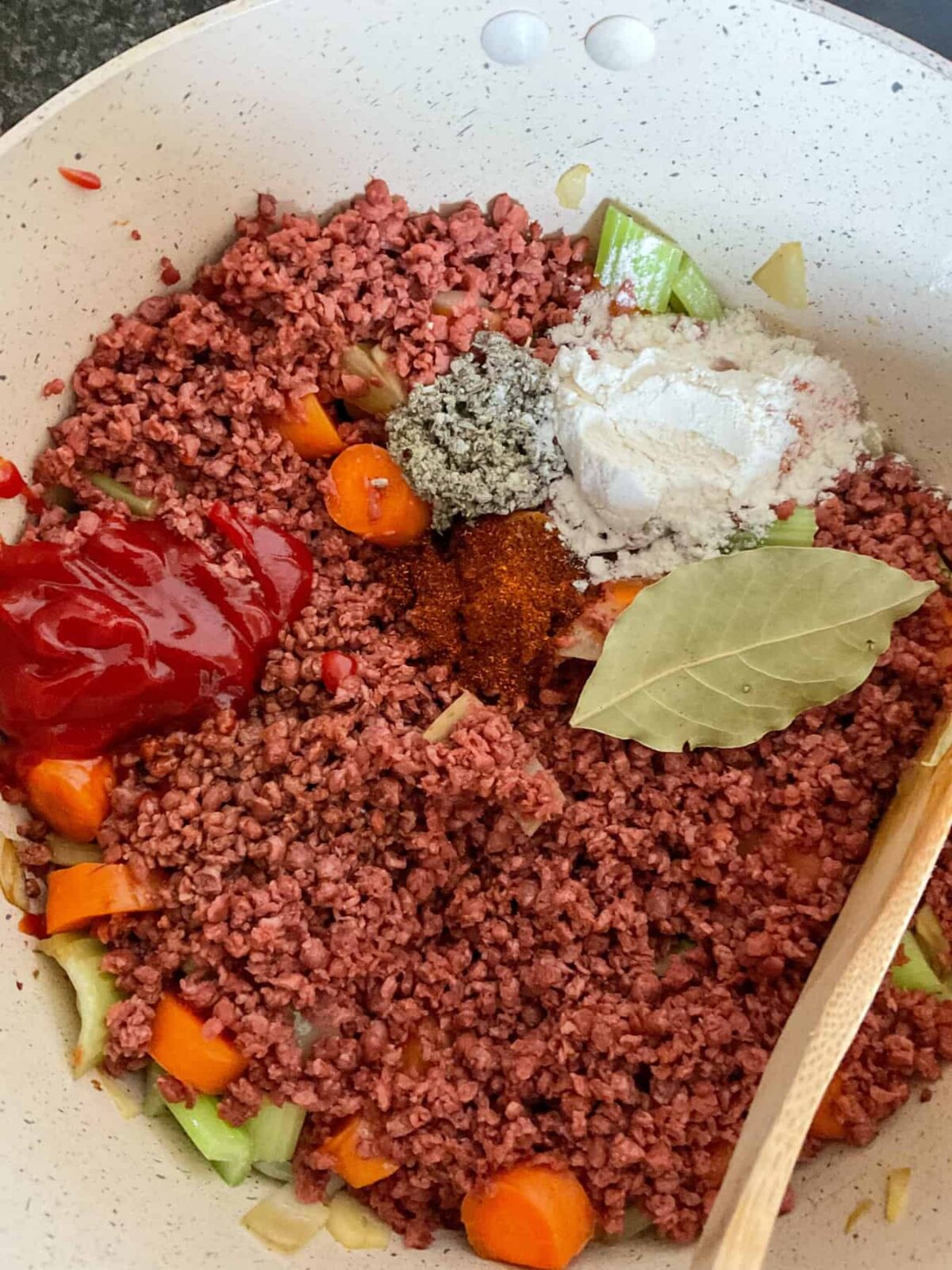
Next, add the vegan mince [crumbles], tomato ketchup, bay leaf, dried sage, chilli powder, soy sauce, and plain flour.
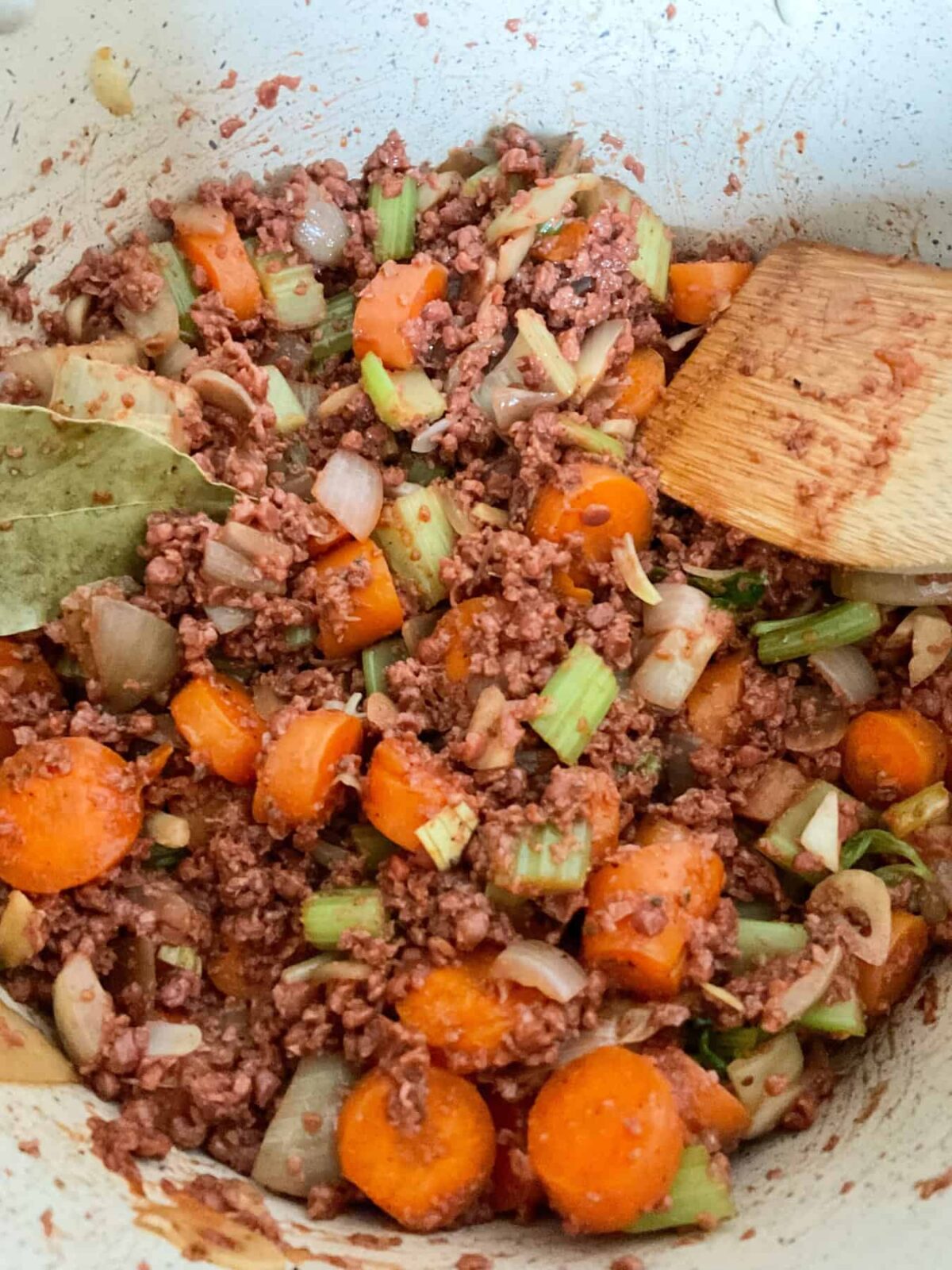
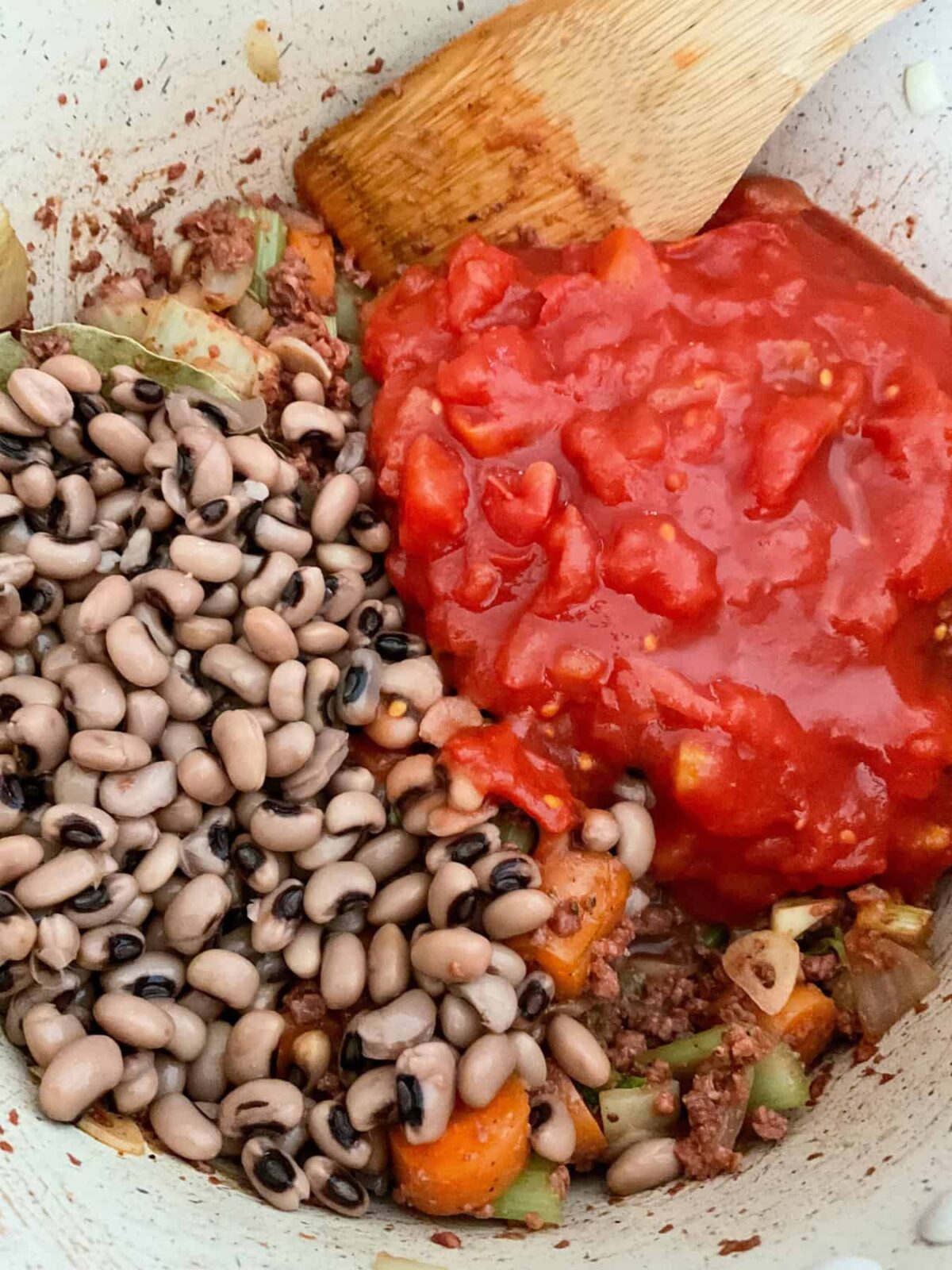
Give it all a good mix.
Next, add the black-eyed beans and the canned tomatoes.


Pour in the vegetable broth and bring it to a gentle boil.
Simmer for 20 minutes, stirring every now and again.
Add the frozen green peas and pop a lid over the pot and cook for another 5 minutes, or until the veggies are soft.

When the stew is ready the veggies will be soft and the gravy nice and thick. Although it will continue to thicken more and more as it is off the heat.
Season to taste with salt and black pepper.
Hint: The stew gravy will continue to thicken as it sits off the heat, so if you prefer more gravy you can add a little extra hot broth. Also, as we use soy sauce and vegetable broth for this recipe its a good idea to wait until the end to add seasoning such as salt, as the simmering will concentrate the flavours, and you don't want an overly salty dish.
Recipe notes and FAQ
Substitutions
This recipe uses fresh vegan mince, or crumbles, but it can be replaced with frozen and thawed vegan mince, or rehydrated dried meat-free mince.
Other possible vegan mince alternatives for this stew include - lentils [such as dried Puy green lentils or brown lentils], finely chopped mushrooms, or other types of plant-based proteins such as burgers, sausages, meatballs, seitan, tempeh, tofu, etc, crumbled up small.
Although just bear in mind that any substitute may alter the cooking time, texture and flavour of the stew.
- Carrots - replace with sweet potato or butternut squash
- Celery - use green bell pepper instead
- Oil-free - instead of olive oil cook the onions in a little vegetable broth
- Dried sage - use any dried herb you prefer
- Chilli powder - replace with paprika powder, or add more chilli powder or some chilli flakes for a spicier stew
- Black-eyed peas - replace with your preferred bean, kidney beans or pinto beans are a good switch
Storage
Store the chuck wagon stew within a food container and keep in the refrigerator for up to 3 days.
Or freeze for 2-3 months.
Reheating
Reheat leftover chuck wagon stew by adding to a stew pot and bringing to a gentle simmer, stir and reheat for a few minutes until the stew is heated throughout.
Yes, with a few considerations vegan chuck wagon stew is great for gluten-free diets.
First, choose a gluten-free soy sauce such as Tamari or go with coconut aminos, also use gluten-free vegetable stock cubes, bouillon cubes, paste or powder to prepare the vegetable broth or stock.
Finally, use a gluten-free plain flour or cornstarch/cornflour, a gluten-free tomato ketchup and a gluten-free vegan mince.
To be 100% sure your ingredient is gluten-free its best to check the ingredient list for all your ingredients, and to look for a gluten-free certification, and to ask the manufacturer if your still unsure.
In general, most brands of tomato ketchup are gluten-free including Heinz ketchup. **Although do check the ingredients before purchasing as recipes and ingredients do change**
[However, Heinz ketchup has risen in cost so much that its worth having a look at supermarket own brands or even the International section of the supermarket for other less known brands, especially Polish brands which tend to be less expensive]
Also, it's important to note that while the ingredients used in ketchup are typically gluten-free (tomatoes, sugar, vinegar, and spices), some brands might add thickeners or flavorings that contain gluten or the vinegar could have been obtained from grains such as wheat or barley, or there could be cross-contamination during production if the same equipment is used for gluten-containing products.
For these reasons, it's always best to check the product label or consult the manufacturer's website if you're following a gluten-free diet.
Also look for ketchup that is labeled as gluten-free, as this indicates that the product meets strict standards for gluten-free labeling in that country. In the US, a product labeled gluten-free must contain less than 20 parts per million of gluten, and in the UK, it's the same threshold.
Yes, most tomato ketchup is vegan, including Heinz. The basic ingredients of ketchup are tomatoes, sugar, vinegar, salt, and various spices and flavorings, all of which are usually plant-based.
However, it's worth noting a few potential issues:
Sugar: In some cases, the sugar used in ketchup and other processed foods can be processed using bone char from animals, which would not be considered vegan. This is more common in the United States than in other countries, and most sugar in the UK is bone-char free.
Natural flavors: The term "natural flavors" can sometimes include animal-derived ingredients. This is usually not the case in ketchup, but it can be difficult to know for sure without more information from the manufacturer.
Honey: Some specialty or gourmet ketchups might use honey as a sweetener, which is not considered vegan.
To be absolutely sure that your ketchup is vegan its always a good idea to check the label or the manufacturer's website if you're not confident, as recipes and ingredients can change, and perhaps look for ketchup that is labeled as vegan to be absolutely certain.
If you can't source tomato ketchup or don't particularly like it, although the ketchup flavour in the stew is not prominent it just adds to the blend of flavours, then give one of the following suggestions a try as a replacement:
Tomato Paste/Puree or Tomato Sauce [Tomato passata]: Tomato paste can be diluted with a bit of water or vinegar, and you can add a little sugar. Tomato sauce or tomato passata can be used as it is with perhaps a teaspoon of vinegar and a pinch of sugar to balance the flavours.
BBQ Sauce: BBQ sauce is often thicker and smokier than ketchup, but it can be used in a similar way in many recipes, and would be very tasty in a chuck wagon stew.
Spicy salsa: If you want something chunkier and with more heat, salsa could be a good option.
Hot Sauce or Sriracha: If you're looking for more of a kick, hot sauce or sriracha can be a good substitute, but they are usually much spicier.
Homemade Ketchup: Make your own ketchup using canned tomatoes, vinegar, sugar, salt, and your own mix of spices. An easy recipe for tomato ketchup will be added here soon so do look out for that if you love ketchup!
Marinara Sauce: Marinara sauce could be a good substitute, just add a few tablespoons to the stew.
HP Sauce, brown sauce, or A.1. Steak Sauce: These are both tangy and sweet sauces, although they have a distinct flavor profile from ketchup they will still taste delicious in the stew, and besides there is often a split between tomato ketchup fans versus brown sauce fans so just use whatever you prefer! There's no point buying a bottle of ketchup just for 2 tablespoons for a recipe and then it sitting in your fridge for ever!
The above ingredients are generally vegan, but as with every shop-bought product do check the ingredient list to be 100% sure especially if there is no vegan certification label.
There are lots of tasty new meal ideas that could be prepared with leftover chuck wagon stew although some ideas may require less liquid to work, and if so simply scoop the stew up using a slotted spoon so that excess liquid drains away before using for a new meal.
Our favourite ideas are to use the stew as the basis for a vegan lasagna, vegan shepherds or cottage pie, vegan spaghetti Bolognese, or add extra chilli powder, a few teaspoons of cumin and paprika powder to the stew to prepare a quick vegan chilli.
Alternatively, heat the leftovers and enjoy as a filling for a baked potato, with sides of perhaps salad and vegan coleslaw.
Or use the stew as a nacho topping by placing spoonfuls on top of potato wedges, sprinkling with cheese and baking. Check out our Loaded Black Bean Potato Wedges recipe for an easy nacho method, and replace the black bean topping with the chuck wagon stew.
Or top the stew with puff pastry and bake for a delicious vegan pot pie.
Lastly, a delicious quick casserole can be prepared by mixing the stew with cooked rice, placing the mixture into a casserole dish, and top with grated vegan cheese or a home-made vegan cheese sauce and bake until everything is bubbling and the top has nice crispy bits.
Mashed or baked white potatoes and cornbread muffins are the perfect accompaniments to a meat-free chuck wagon stew or even any meat-free stew.
Mashed or baked sweet potatoes are also a great side, as are mashed cauliflower, or a mashed potato mixture such as this Classic British Champ [mashed potatoes, turnip [rutabaga] and cabbage].
Other ideas are rice, pasta, thick noodles, barley, quinoa, wheat grains, whole-grain bread or a slice of this Irish Soda Bread or this Boston Brown Bread.
Your favourite crackers are also a tasty addition, including these Scottish Oatcakes. Also, American biscuits are a traditional side but for a British alternative try one of these Buttermilk Scones.
A scoop of Baked Beans in a Tomato Sauce is a nice side as are a ladle full of Boston Baked Beans.
Other ideas include:
* Pickled vegetables, such as beetroot, cucumber, onions, cabbage
* Tomato ketchup or brown sauce, or your favourite condiments
* Vegan sour cream
* Hot sauce
* Fresh herbs garnish such as parsley, cilantro [coriander], chives, dill, spring onions [scallions]
* Nutritional yeast flakes
* Paprika flakes or red pepper flakes
Lastly, a scoop of chuck wagon stew can be used as a delicious Vegan Carrot Hot-Dog topping. Perfect for summer out-door cook-outs, camping trips and BBQs.
Yes, making chuck wagon stew in a slow cooker or crock-pot is a great idea. Begin by adding all the ingredients [except the frozen peas] into the slow cooker, but decrease the quantity of vegetable broth to 2 cups, or 500 millilitres.
Then, set the cooker on high for 4 hours. Alternatively, you could choose to cook it for a longer period on the lower settings. Add the frozen peas to the slow cooker about 20 minutes before serving the stew.
Please note, the precise cooking time will vary based on the size of the vegetable pieces.
For instance, diced carrots and celery will cook faster than chunkier pieces, so if you're using larger chunks, adjust the cooking time accordingly.
If at the end of cooking the stew is too thick, simply add a little extra vegetable broth.
Or if the stew is too thin and you'd like to thicken it up then prepare a cornflour [cornstarch] slurry.
We have an easy method for a cornstarch slurry over in the FAQ section of our Vegan 'chicken' Mango Curry recipe post.
Yes, chuck wagon stew can be easily cooked in a pressure cooker or an Instant Pot and this can speed up the cooking process even more.
Here's a suggested method:
Ingredients: Same as our recipe.
Instructions:
1. Using the sauté function on your pressure cooker, heat the oil.
2. Cook the onions over a medium heat for 5 minutes, stirring a few times.
Next add the garlic, carrots, and celery, and cook for another minute, stirring frequently.
3. Now, add the vegan mince, tomato ketchup, soy sauce, bay leaf, chilli powder, dried sage, and plain flour, stirring well.
4. Pour in the canned tomatoes and the black-eyed beans.
5. Pour in the hot vegetable broth.
6. Lock the pressure cooker lid in place and set the valve to sealing. Cook on high pressure for 10 minutes.
7. Allow the pressure to release naturally for 10 minutes, then quick release the remaining pressure.
8. Turn the sauté function back on, add the frozen peas and cook for a further 5 minutes.
9. Stir well, remove the bay leaf and season with salt and pepper to taste.
Remember, pressure cookers can vary so you might need to adjust the cooking time based on your specific model. If you find that the vegetables aren't fully cooked after the pressure cooking phase, you can always put the pressure cooker on sauté for a few more minutes until they reach your preferred texture.
Also, keep in mind that pressure cookers need liquid to create steam and build pressure, so be sure not to reduce the amount of vegetable broth too much, even if you want a thicker stew.
If the stew is too thin after pressure cooking, you can use the sauté function to simmer and reduce the liquid, or you can mix in a slurry of cornflour [cornstarch] and water to thicken it.
Yes, you can double this recipe and the cooking times should remain the same. Preparing 2 batches of stew means less cooking for a future dinner, as one batch can be easily frozen.
If you're cooking a double batch in a pressure cooker, just make sure not to fill it more than two-thirds full to allow for proper pressure building.
The difficulty in softening carrots and celery in a tomato-based liquid has to do with the acidity of tomatoes. Acidic ingredients can slow down the process of breaking down the cell walls in certain vegetables, making them take longer to soften.
Also, both carrots and celery are dense vegetables, which means they naturally take a longer time to cook compared to vegetables with higher water content.
However, there are a few ways to ensure these vegetables soften properly in a tomato-based stew:
Sauté Beforehand: Sautéing the carrots and celery in oil before adding them to the stew can begin the process of breaking them down. This helps them soften more quickly once they're in the acidic tomato base. Although, it doesn't have to be oil that the veggies are sautéed in as a small amount of vegetable broth works just fine.
Size Matters: Cutting your vegetables into smaller pieces can also help them cook more quickly. Smaller pieces of vegetables cook faster, however for a stew its more desirable for the vegetables to be chopped into chunks rather than diced which is more appropriate for a soup.
Cooking Time: Ensure you're giving the stew enough time to simmer. Dense vegetables like carrots and celery require a longer cooking time to become tender, which is why carrots and celery generally cook well in a slow cooker.
Pressure Cooking: Using a pressure cooker can significantly reduce the cooking time of dense vegetables like carrots and celery in a stew.
A common challenge for many new vegans and those adopting a plant-based diet is eating enough to feel full.
Home-cooked stews and soups, although wholesome and nutritious, often incorporate ingredients that are low in calories and fat.
Consequently, many individuals find themselves feeling hungry shortly after a meal.
I have first-hand experience with this, as most days it feels like my kids are baby birds always cheeping for more food!
Here are a few tips for making a vegan stew more filling and satisfying:
1. Proteins: Adding plant-based proteins will help make your stew more filling. Consider adding lentils, chickpeas or any pulse, tofu, tempeh, or seitan.
2. Complex Carbohydrates: Complex carbs are not only filling but also provide sustained energy. Try adding root vegetables like sweet potatoes, parsnips, turnips [swede/rutabaga] or regular potatoes. Whole grains such as barley, quinoa, brown rice, or wholegrain pasta, can also be a good addition.
3. Healthy Fats: Incorporate sources of healthy fats, like avocados, olives, or nuts and seeds, which can give your stew a richer texture. Coconut milk can also add creaminess and depth of flavour to a stew but for a chuck wagon stew this is perhaps not the flavour profile we are going for! Using olive oil to saute veggies adds extra calories, which in turn, can help the stew feel more filling, as vegetable based stews tend to be low in calories and fat.
4. Fiber: Adding more fiber can also help to make your stew more satisfying. This can come from a variety of vegetables (such as carrots, celery, bell peppers, spinach, or kale) or beans and lentils. Meat-free mince [crumbles], textured vegetable protein {TVP] pieces or dried soya chunks are also a good source of fiber.
5. Umami Flavor: This is the savory taste that can make meals more satisfying. You can get it in your vegan stew from ingredients like mushrooms, soy sauce, vegan Worcester sauce, nutritional yeast flakes, vegan beef or chicken flavour stock or bouillon cubes, marmite, or miso paste.
6. Herbs and Spices: Don't forget to season your stew well. Dried and fresh herbs and spices not only add flavour but can also make a meal feel more satisfying. Use a variety of spices and don't be afraid to experiment with flavours as you may discover something really special!
Lastly, for extra hungry eaters if possible do offer crusty bread or your preferred bread product, or alternative, along with the stew as this can help bulk out the meal and make it more satisfying for some people, including my kids!
Growing up in Glasgow during the 80s and 90s it was traditional to serve bread and butter with every single meal as this was an inexpensive way to bulk out the meal and keep us full. Although, I say butter, it was more likely to be an orangey-yellow coloured margarine as butter was too posh an ingredient!
Pairing suggestions
These are our favorite Vegan Side Dishes to serve with vegan chuck wagon stew:
More delicious meat-free family meals
Looking for more Vegan Dinner Recipes?
These are some of our family favourites that we enjoy throughout the chillier months although as we live on a Scottish Island, with variable weather [often 4 seasons in one day!], we enjoy these meals during the summer months as well!
Our slow cooker is put to work year-round so we often have this Slow Cooker Vegan Campfire Stew cooking away and this Slow Cooker Vegan Mince and Tatties.
And whenever we need a good doze of vegan comfort food this Vegan Cowboy Pie is utterly delicious, and for those busy days this Vegan Quick Tempeh Spaghetti Bolognese is perfect.
***please note: for US measurements click the 'US customary button' within the recipe and the measurements will switch to tablespoons, cups, and ounces.***
📖 Recipe

Vegan Chuck Wagon Stew
Equipment
- Stew or soup pot with lid
- Saucepan
Ingredients
Precook the carrot and celery:
- 125 millilitres vegetable broth [vegetable stock]
- 3 medium carrots sliced into rough bite sized chunks
- 3 ribs celery sliced into rough bite sized chunks
Saute onions and garlic:
- 1 tablespoon olive oil [or replace with 125ml [½ cup] of vegetable broth]
- 1 medium-large onion rough chopped
- 4 garlic cloves [use more if your cloves are small]
Stew:
- 300 grams vegan mince [either fresh or frozen, thawed]
- ½ teaspoon mild chilli powder [use more if spicier is preferred]
- 1 teaspoon dried sage [or your preferred dried herb]
- 1 bay leaf
- 1 tablespoon plain flour [all-purpose flour or replace with gluten-free plain flour or cornstarch/cornflour]
- 2 tablespoon soy sauce [use Tamari if gluten-free required]
- 2 tablespoon tomato ketchup [see FAQ section above for alternatives]
- 1 can black eyed beans [black eyed peas] 400g [14oz] can
- 1 can chopped tomatoes [canned diced tomatoes] 400g [14oz] can
- 1 litre vegetable broth hot, [use a vegan 'beef' flavour if available such as OXO meat free beef flavour stock or bouillon cubes]
Add 5 minutes before end of cooking:
- 160 grams frozen peas
Instructions
Pre-cook the carrot and celery:
- Heat the vegetable broth in a non-stick pan and add the carrot and celery chunks. Pop a lid over and simmer for 10 minutes until the veggies are nearly softened. Add a few tablespoons of water or broth whenever it looks like the liquid may run dry.125 millilitres vegetable broth, 3 medium carrots, 3 ribs celery
Prepare the stew:
- Heat the oil in a soup or stew pot.1 tablespoon olive oil
- Cook the onions over a medium heat for 5 minutes, stirring the onions a few times.1 medium-large onion
- Next add the garlic, pre-cooked celery and carrot, and cook for another minute, stirring frequently,4 garlic cloves
- Now, add the vegan mince, tomato ketchup, soy sauce, bay leaf, chilli powder, dried sage, and plain flour, stirring well.300 grams vegan mince, ½ teaspoon mild chilli powder, 1 teaspoon dried sage, 1 bay leaf, 2 tablespoon soy sauce, 2 tablespoon tomato ketchup, 1 tablespoon plain flour
- Pour in the canned tomatoes and the black-eyed beans.1 can black eyed beans, 1 can chopped tomatoes
- Pour in the hot vegetable broth and bring the stew to a gentle boil.1 litre vegetable broth
- Cook for 20 minutes, stirring a few times.
- Add the frozen peas and pop a lid over the pan and cook for a further 5 minutes or until the veggies are cooked and the stew is nice and thick. Although the stew will continue to thicken as it sits off the heat.160 grams frozen peas
- Stir well, remove the bay leaf, and season with salt and pepper to taste. A little fresh chopped parsley is a nice optional addition.
Notes
- Nutritional data is for guidance only and is not an exact calculation as ingredients vary.
- Pre-cooking the carrot and celery chunks is optional as they can simply be sautéed for about 5 minutes after the onions have cooked, but they will take much longer to soften up in the stew, so you will need to adjust cooking times.
- If cooking the stew over a campfire the additional cooking may not be an issue.
- The vegan mince used for this recipe was fresh Better Naked Evolution plant-based mince, but any vegan mince or crumbles can be used either fresh, frozen or rehydrated dried meat-free mince [such as TVP].
- The vegetable broth was made with 3 OXO meat free beef flavour stock cubes stirred through 1 litre [1 quart] of boiling water. Any vegetable stock or bouillon cubes can be used, but for a beefy flavour go with a vegan beef stock cube, paste or powder.
- Store leftovers in the refrigerator for up to 3 days.
- Or freeze for 2-3 months.
- Reheat in a non-stick pan by gently bringing to a boil and simmering for 2-3 minutes until hot throughout. Add extra vegetable broth if necessary.
- Replace the black eyed beans with any pulse such as pinto, kidney beans, chickpeas, etc.
- For a gluten-free stew use Tamari soy sauce, gluten-free plain flour or cornstarch/cornflour, and a gluten-free vegetable broth. Also check that your tomato ketchup and vegan mince is gluten-free.
- To prepare in a slow cooker:
- Add all the ingredients into the slow cooker [except frozen peas], but decrease the quantity of vegetable broth to 2 cups, or 500 millilitres. Cook on high for 4 hours. Alternatively, cook it for a longer period on the lower settings. Add the frozen peas for the last 20 minutes of cooking.
- The precise cooking time will vary based on the size of the vegetable pieces. For instance, diced carrots and celery will cook faster than chunkier pieces, so if you're using larger chunks, adjust the cooking time accordingly.
- If at the end of slow cooking, if the stew is too thick simply add a little extra vegetable broth. Or if the stew is too thin and you'd like to thicken it up then simply prepare a cornflour [cornstarch] slurry. We have an easy method for a cornstarch slurry over in the FAQ section of our Vegan 'chicken' Mango Curry recipe post.
- For a pressure cooker or Instant pot cooking method have a look at our recipe notes and FAQ section above the recipe.
Nutrition
Thank you for reading our vegan chuck wagon recipe post and getting this far! Do tag us using @traditionalplantbasedcooking if you make the stew and share a photo! We love seeing your tasty food! All the best, Jacq x
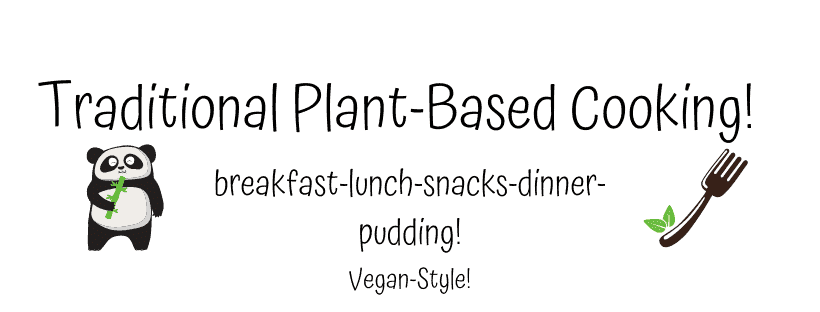

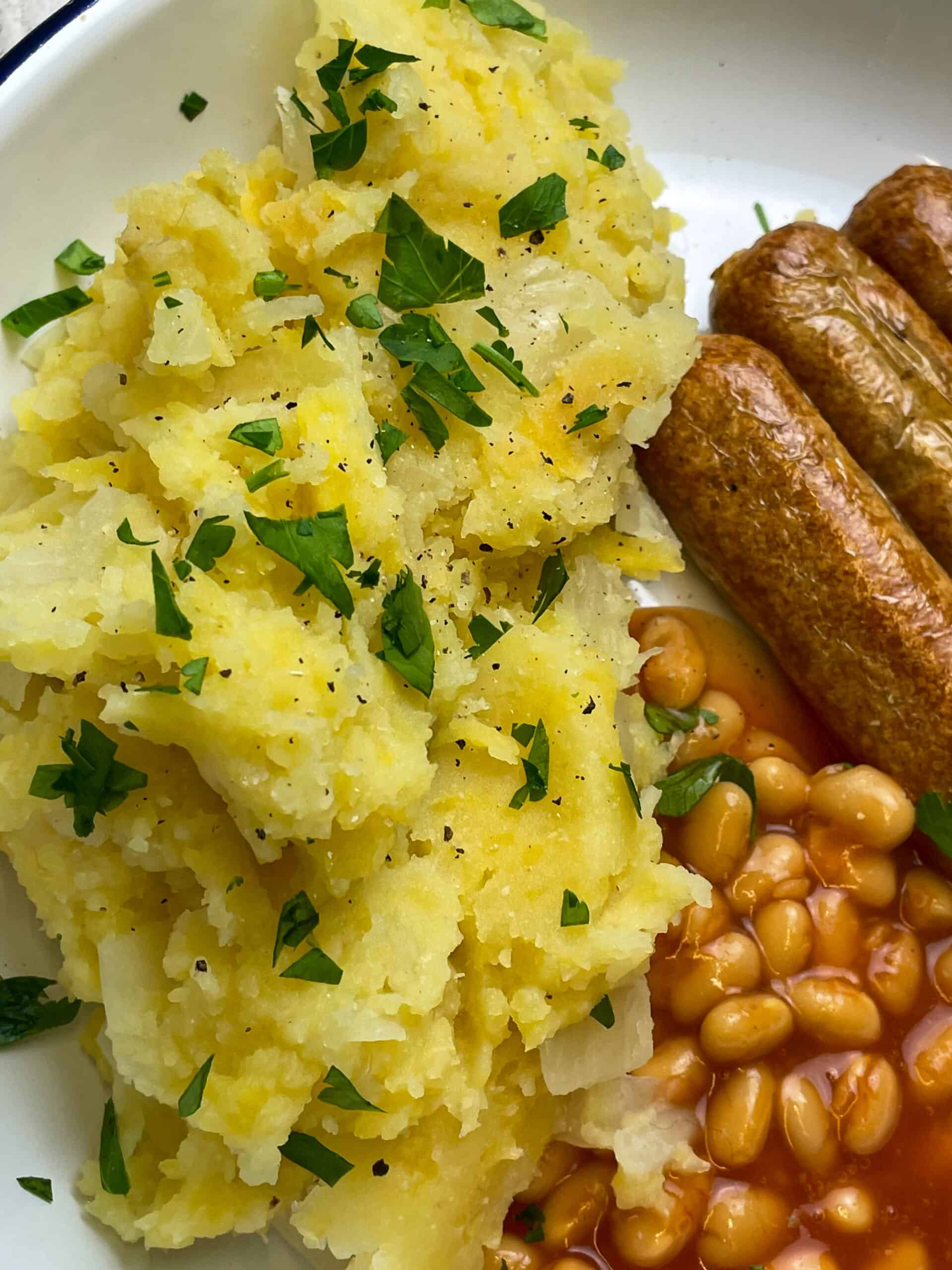
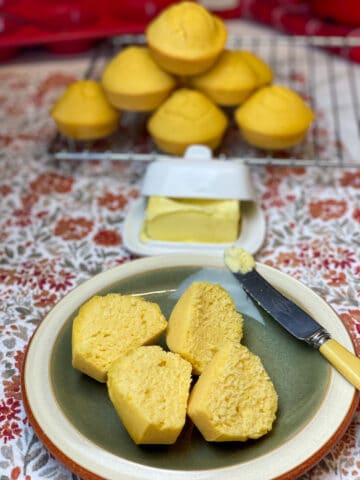
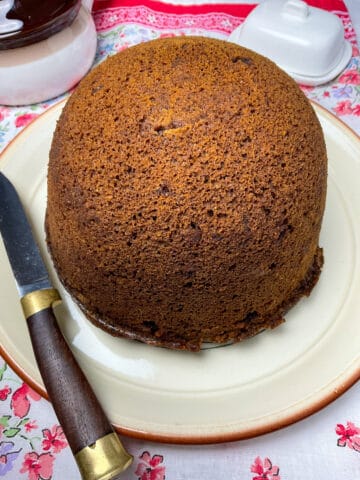
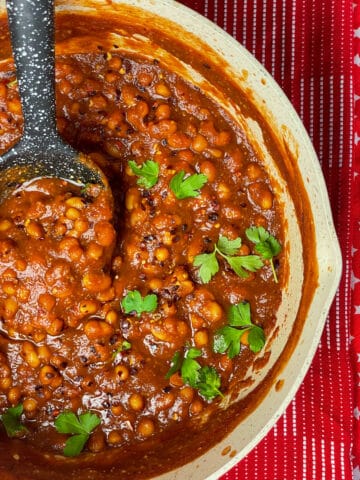
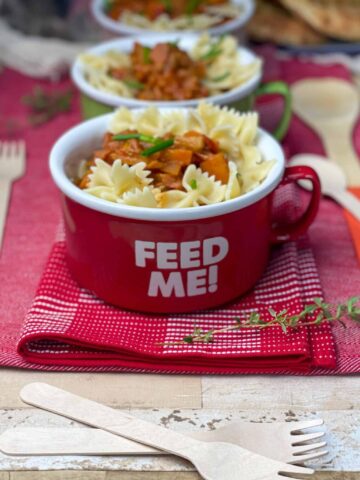
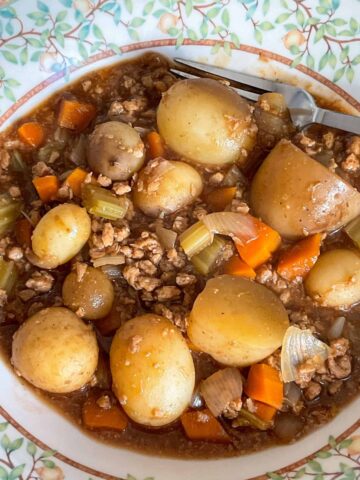
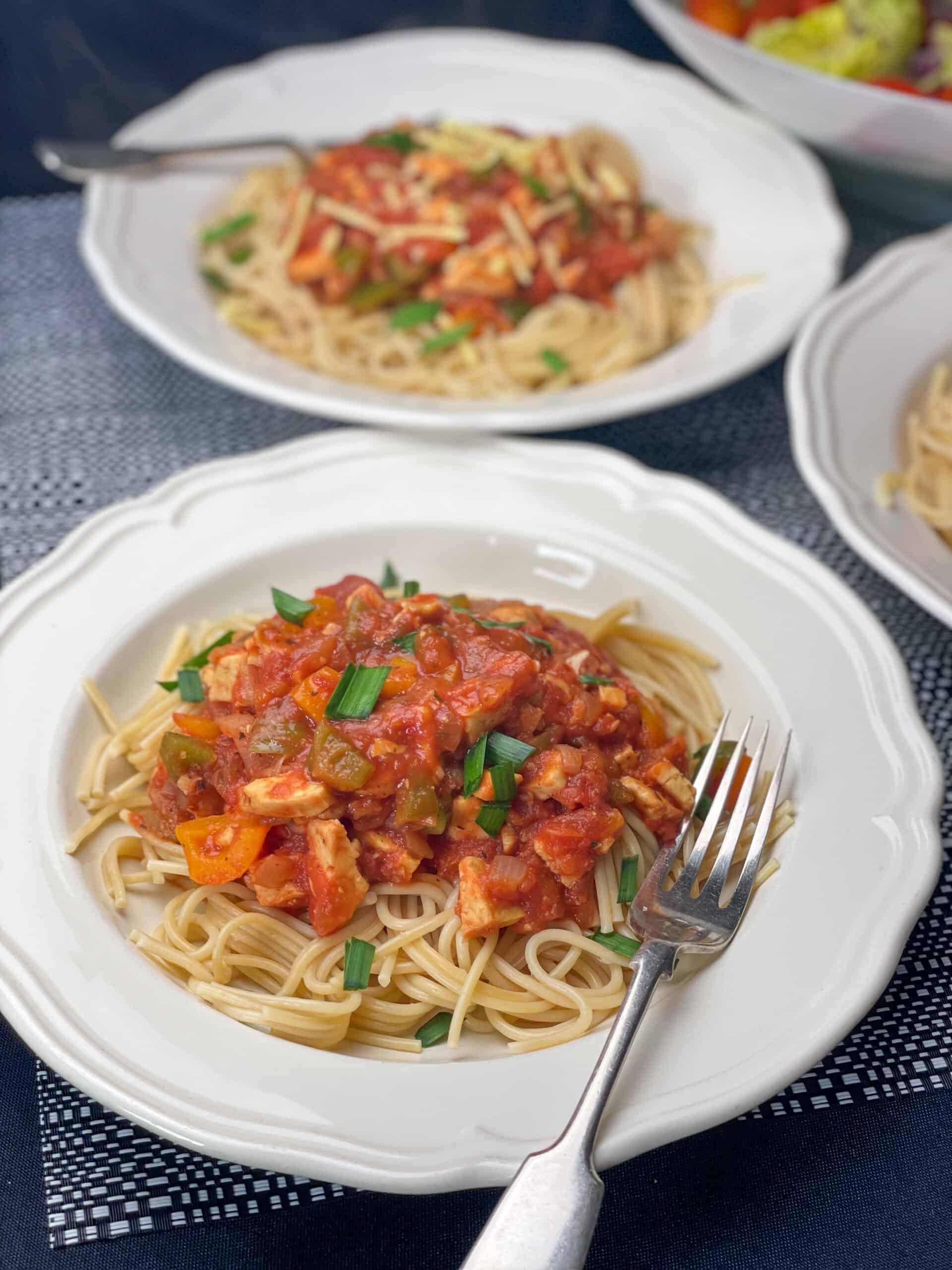
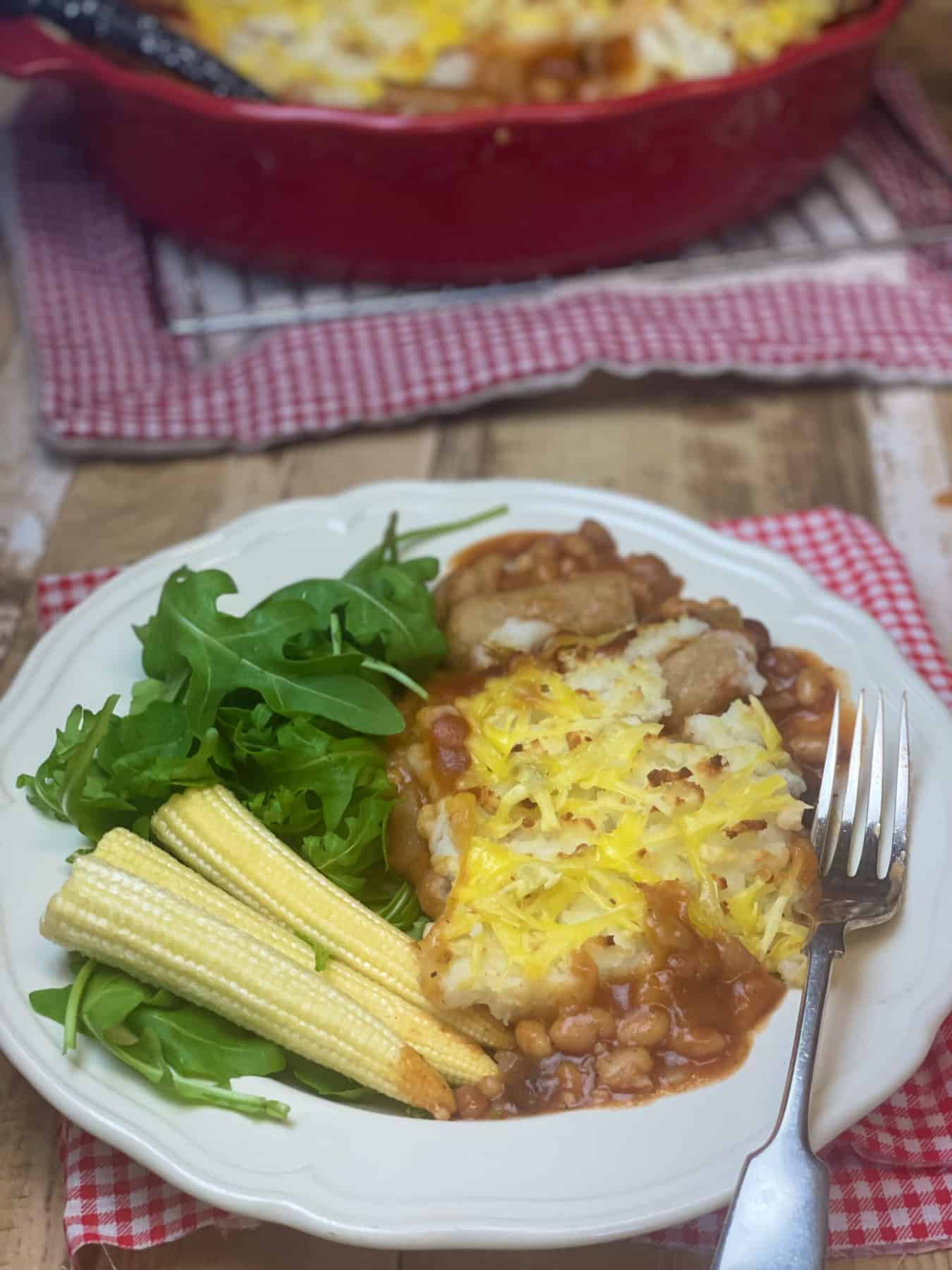
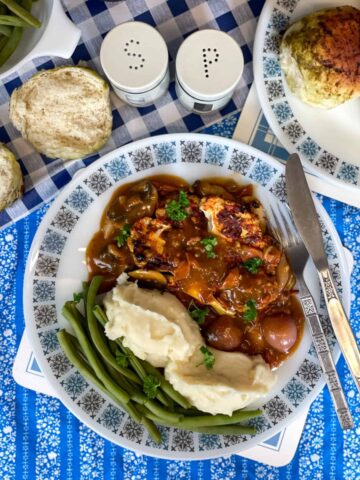
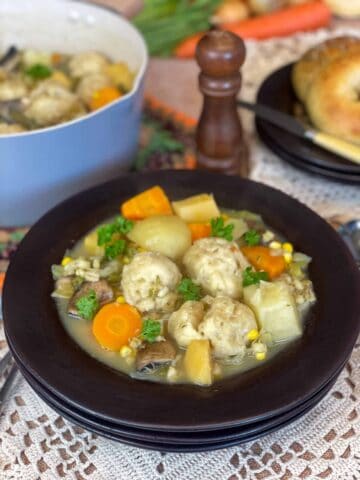
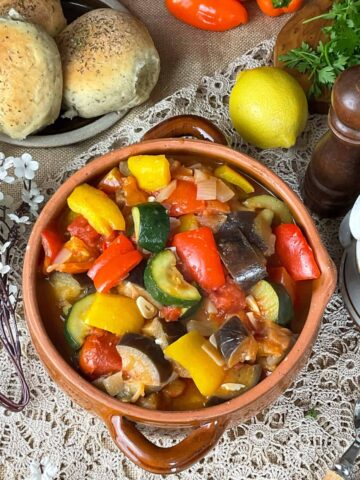
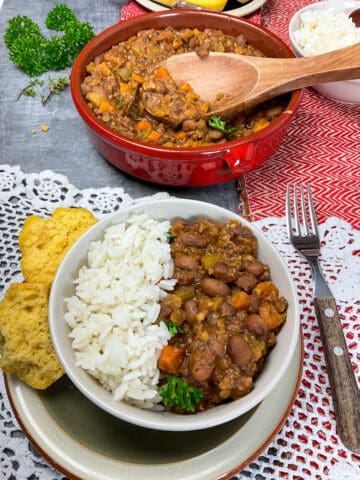
Leave a Reply